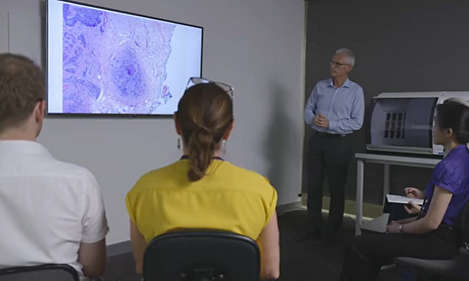What is the need for digital pathology and how is it streamlining the diagnostic process?
By Philips ∙ máj 01, 2024 ∙ 4 min read
While cancer cases are growing1, the number of pathologists worldwide is not2. Philips digital pathology helps reduce the pressure on pathologists by streamlining workflow, sharpening diagnostic processes, facilitating partnership and enabling collaboration regardless of location. Digital pathology can increase productivity by up to 18%3 because it eliminates time-consuming administrative tasks, reduces costs and enhances lab performance. Digitized workflow streamlines the diagnostic process and connects teams to maximize resources, while unified patient data supports informed decision-making.
Article at a glance

Digital pathology allows pathologists to leave the microscope behind and increase productivity
Philips digital pathology aims to reduce the pressure on pathologists by streamlining workflow, sharpening diagnostic processes, facilitating partnership and enabling collaboration regardless of location.
Digital pathology could have immediate implications for patient care as well: the digital workflow could eliminate issues with handling materials and could detect abnormalities as they occur. Digitization also means pathologists no longer have to worry about the risk of losing or damaging specimens. The application of this technology could increase productivity by up to 18%3 because it eliminates time-consuming administrative tasks, reduces costs and enhances lab performance. Technology, both in the field of scanning and IT, has now finally met the necessary standards for digital pathology in terms of software maturity and network, computing and storage capability.
Clinical pathology laboratories outside of the U.S. that have completed their transition to digital pathology include Saint-Joseph Hospital in France, Hospitals Granada in Spain, Hall im Tirol and Innsbruck in Austria, IDEXX (globally) and Finn in the UK. The Philips IntelliSite Pathology Solution4 is allowed to be marketed for primary diagnostic interpretation and sign-out of digital pathology slides prepared for formalin-fixed paraffin embedded (FFPE) tissue.

Is digital pathology right for you? Planning ahead and making the business case
Making a good business case for digital pathology is all about planning ahead. Figure out what you want your digital laboratory to look like, what changes you need to make and where you need to invest. When you have the answers to those questions, you should be able to make a smooth transition and get a favorable return on your investment. In the long-term, digital pathology’s benefits outweigh its costs. Digital pathology simplifies logistics, saves time and allows pathologists to work more efficiently. Philips has a business case tool that can help labs decide if the transition to digital pathology is right for them.
Advantages of digital pathology in logistics and diagnostic time
The first main advantage to digital pathology is logistics. You don’t have to go through your physical archives anymore, you don’t need an administrative assistant to manage your storage and filing systems and you can save money by optimizing your staff and space requirements.
You might be interested in reading the Histopathology article “Evaluating the benefits of digital pathology implementation: Time savings in laboratory logistics” by Alexi Baidoshvili, Anca Bucur, Jasper van Leeuwen, Jeroen van der Laak, Philip Kluin and Paul J van Diest. The second main advantage is diagnostic time. Digital diagnostics, including viewing slides digitally, is faster than the microscope. That means you increase both capacity and efficiency. On top of that, the quality of digital diagnostics is actually better than that of slide-based work.5
In a traditional laboratory, a glass slide is moved several times from the archive to the pathologist workstation and back. With digital slides, these unnecessary logistics are eliminated. The work becomes both faster and more convenient, and personnel can be allocated to other work.

Assess the potential benefits of going digital when it comes to pathology
To enable the profession to harness the full potential of digitization, Philips has created a unique resource, the Digital Pathology Business Case Tool. Its algorithms map out the unique process flow analysis of a lab and provide the means to present the strongest possible financial argument to the key stakeholders in healthcare organizations. The data combines Philips evidence-based analysis with the independent experience of European labs already benefiting from digital workflow.
This is helpful in assessing the potential of a fully digital histopathology workflow. Digital pathology is not just streamlining slide assessment. Crucially, the tool enables a lab to map out its own unique process flow analysis. It presents a core template which can be customized with data relevant to the specific challenges or specializations of a particular hospital. The breadth of detailed cost projections that the tool provides includes process input and investment expenditure, ranging from the costs involving scanners and changes in IT infrastructure, to the provision of the algorithms that underpin the image analytics.
As part of quantifying workflow cost reductions for a post-digitization environment, it looks at the current cost of archiving, existing infrastructure for example microscopes and other renewals, maintenance, floor space, repeat work due to breakages as well as the cost of the algorithms for image analytics. Once the lab’s individual data is incorporated, the system creates a business case based on several financial modelling methods including the ones that are supported by Philips Capital. This is a complimentary resource, with Philips also providing the service of its experts if labs need assistance in carrying out this information-gathering analysis.
Brochure: Unlock a new era of efficiency and improved patient care
Footnotes
1. World Cancer Report, WHO (2014)
2. Physician Specialty Data Report, AAMC (2016)
3. Alexi Baidoshvili, webinar 'The benefits and challenges of digitizing your workflow', Mar 1, 2017 5:00 PM - 6:00 PM CET
4. The Philips IntelliSite Pathology Solution has obtained market access clearance as IVD for primary diagnosis in approx. 50 countries, such as EEA (European Economic Area), USA, Canada, Japan, South Korea, and other countries in Asia, Middle East and South America.
5. Productivity gains: Philips DCP survey (2018)




